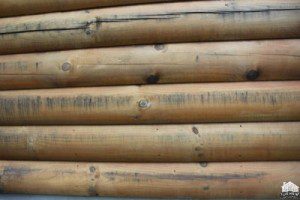Chemical Stripping
Stripping and Pressure Washing
 Prior to applying stain to a log home, old stain, contaminants, and UV-damaged wood needs to be removed. There are many different processes through which this can be accomplished, such as power washing or chemical stripping. The process that is right for you and your home should be determined by a knowledgeable applicator that has the experience and expertise necessary to understand what is required. These steps are absolutely critical to a long-lasting and attractive stain.
Prior to applying stain to a log home, old stain, contaminants, and UV-damaged wood needs to be removed. There are many different processes through which this can be accomplished, such as power washing or chemical stripping. The process that is right for you and your home should be determined by a knowledgeable applicator that has the experience and expertise necessary to understand what is required. These steps are absolutely critical to a long-lasting and attractive stain.
Not all houses should be pressure washed. Pressure washing is a process generally reserved for use only if the stain is in decent shape and the wood is being prepared for a maintenance coat, or the wood just needs dirt and oils removed. Pressure washing also puts poorly sealed homes at risk for water infiltration.
No Chlorine Bleach!!!Â
If a contractor or applicator suggests chlorine bleach, you have the right to question their judgement. Bleach used to be the tried and true way to prepare wood for stain, but the horse and buggy used to be the tried and true way to get from point A to B as well.
Chlorine bleach application might brighten the wood, and kill mildew, but it breaks down the lignin, or natural glue that binds the wood fibers together. When stain is applied to these broken fibers it significantly decreases the life of your stain.
Think of it as painting over rust…how long would you expect your paint to last? It is also very difficult to completely wash bleach off of wood…have you ever gotten bleach on your hand and tried to wash it off with scrubbing and warm water? The cold water used when pressure washing makes it even more difficult.
Log wash is a liquid concentrate that helps to kill mold and mildew while maintaining the natural PH balance of wood, thus preventing wood fiber damage, and tannate stains.
Iron Tannate Stains Staining